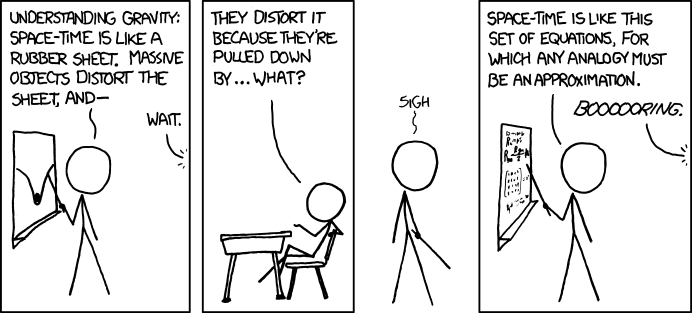Difference between revisions of "895: Teaching Physics"
(→Explanation) |
|||
| Line 17: | Line 17: | ||
Laws of physics (with General Relativity being one example) are expressed mathematically; any description in English is by necessity an analogy. To really understand the physics, you have to understand the mathematics, since any analogy will always fail at some level. However, many people find mathematics to be boring and the analogies to be interesting. The strip highlights the irony of finding the incorrect explanation (the analogy) interesting and the real explanation (the mathematics) boring. | Laws of physics (with General Relativity being one example) are expressed mathematically; any description in English is by necessity an analogy. To really understand the physics, you have to understand the mathematics, since any analogy will always fail at some level. However, many people find mathematics to be boring and the analogies to be interesting. The strip highlights the irony of finding the incorrect explanation (the analogy) interesting and the real explanation (the mathematics) boring. | ||
| + | |||
| + | The title text refers to Richard Feynman's almost unique ability to find really good analogies, which in some cases were exact and precise. One of the best and most famous examples of the latter is [https://en.wikipedia.org/wiki/Feynman_diagram Feynman Diagrams], which allows people to visualize and intuitively understand extraordinarily complex mathematical expressions (specifically, S-matrix elements that form transition amplitudes in quantum field theory). | ||
==Transcript== | ==Transcript== | ||
Revision as of 14:57, 19 September 2022
Explanation
The comic makes fun at the idea that physics is only interesting because teachers use interesting analogies, despite the fact that they are over-simplified and don't help when more complex theory is taught. The comic refers to the classic "Ball on a rubber sheet" metaphor as a way to explain general relativity, even though the metaphor breaks when trying to explain what causes gravity. The fourth panel highlights this with the statement that space-time is a set of equations, for which no analogy can fully explain.
The title text continues the teacher's frustration with coming up with an analogy by stating that there is some analogy that is both understandable and precise, and if he were the famous physicist/teacher Richard Feynman he could come up with it. Professor Feynman was famous for his physics lectures and their ability to both entertain and educate his students, from the beginning student to the more advanced graduate students. Recordings of his lectures are still available and applicable to today's audience.
Another comic shows how to play with this 1158: Rubber Sheet.
A similar, but slightly different explanation
Laws of physics (with General Relativity being one example) are expressed mathematically; any description in English is by necessity an analogy. To really understand the physics, you have to understand the mathematics, since any analogy will always fail at some level. However, many people find mathematics to be boring and the analogies to be interesting. The strip highlights the irony of finding the incorrect explanation (the analogy) interesting and the real explanation (the mathematics) boring.
The title text refers to Richard Feynman's almost unique ability to find really good analogies, which in some cases were exact and precise. One of the best and most famous examples of the latter is Feynman Diagrams, which allows people to visualize and intuitively understand extraordinarily complex mathematical expressions (specifically, S-matrix elements that form transition amplitudes in quantum field theory).
Transcript
- Cueball: Understanding gravity: Space-time is like a rubber sheet. Massive objects distort the sheet, and-
- Student: Wait.
- Student: They distort it because they're pulled down by... what?
- Cueball: sigh
- Cueball: Space-time is like this set of equations, for which any analogy must be an approximation.
- Student: Boooooring.
Discussion
I guess that this emphasize how a good intended teacher try to explain the general parts of the topic with simple words and this is ruined by a douche student.... I think that is the same student that says "Boooooring" when the teacher explain it without any analogy. Pablo Ochoa
I hit something like this when analogising the expansion of the Universe with dots on a balloon... people have a hardtime ignoring the insides of the balloon and think that is the centre. Goes to show how analogies can only go so far. (141.101.99.240 14:56, 14 January 2014 (UTC)MARK ZAMBELLI, edited 20140114)
Maybe the problem with the universe is that the actual topography of the universe is still unknown. So since nobody knows what is the shape of the universe, it makes indeed little sense to try to define a centre. If the universe turns out to be a sphere (even if it doesn't seem likely) we could define a centre.Meneldal (talk) 02:16, 29 January 2015 (UTC)meneldal
- I understood the positive curvature version of the Universe as one where the Universe is the surface of a 4D sphere, where there is no real centre.
An analogy doesn't have to be perfect, it just has to be helpful. It is meant to be a stepping stone between not understanding and full understanding, so your mind can take two smaller leaps instead of one huge one. Apologies for the poor analogy. 108.162.219.58 21:36, 5 February 2014 (UTC)

